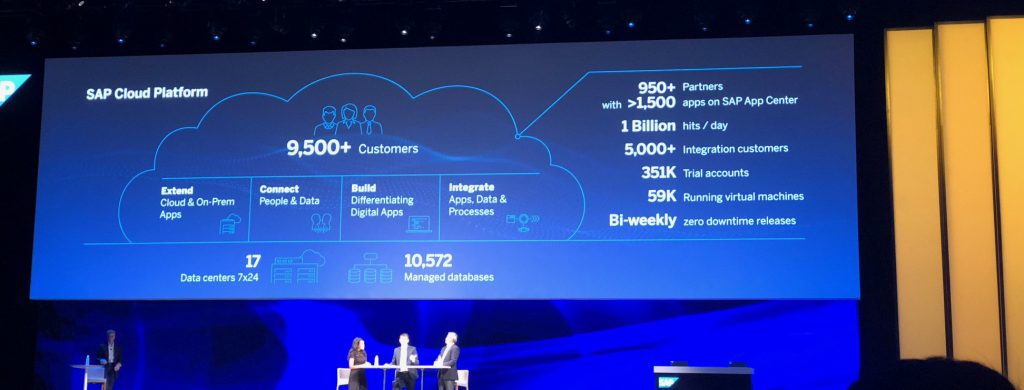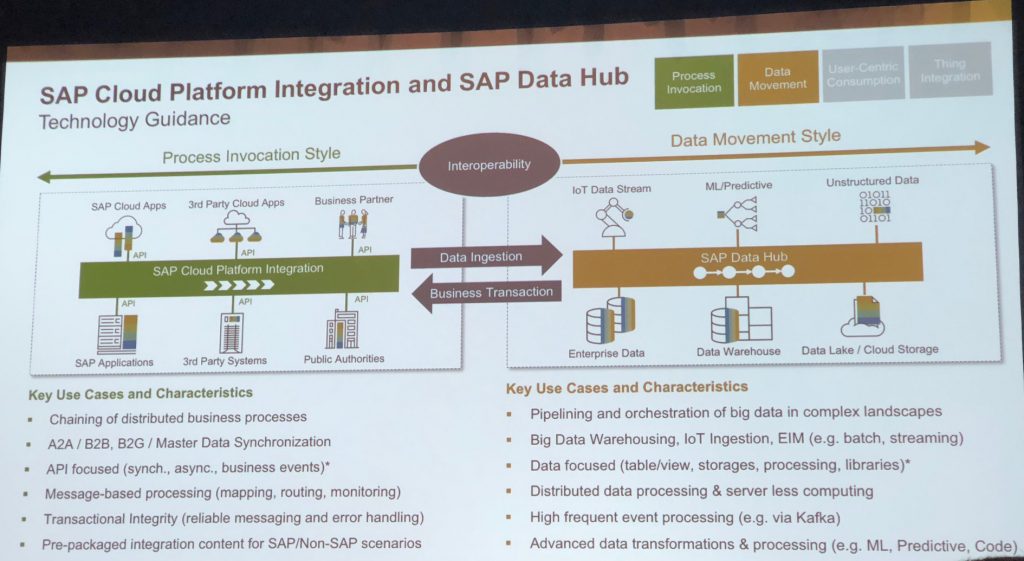SAPPHIRE in Orlando this year was fun. Great to see that SAP acknowledges (more than ever) that integration is key.
A new version of the CIO Guide for Integration (“Process and Data Integration in Hybrid Landscapes“) was also released last week which covers recommendations how to best integrate SAP and Non-SAP solutions.
Integration is really key, although Bill´s statement from the keynote might confuse people (see my comment about SAP HANA Data Management Suite):
And it appears in the Top-10 Take-aways from SAP´s CEO:
Here are my personal key take-aways from an integration perspective:
- SAP Cloud Platform
- SAP HANA Data Management Suite
- SAP S/4HANA Cloud Integration
SAP Cloud Platform (1)
…is really big and the adoption is great (mainly driven by CPI customers) already today. There was also an announcement about a partnership with Cloud Elements, a company which allows to consume the APIs of various Non-SAP solutions. It will be made available under the name SAP Cloud Platform Open Connectors in Q3 (pricing not clear yet). This means, customers can then start using the APIs directly, but also from CPI (via HTTP/OData Adapter).
SAP HANA Data Management Suite (2)
…is the new umbrella (it is not a product itself) to address integration topics. It contains all strategic technology components to integrate data and processes.
Again: It means, integration through data exchange remains, but integration through data sharing will be also possible (mainly using pipelines in SAP Data Hub). Basically you can leave large amounts of data where they are (e.g. IoT data coming from sensors in Hadoop) and access them remotely without the need to replicate them into HANA (and pay for the high memory need).
What is also great: Data Intelligence as part of SAP Leonardo (Data-as-a-service). Will be exciting to hear more about that soon…
SAP S/4HANA Cloud Integration
S/4HANA Cloud is already closer than I thought. Many customers ask for it already, till now I thought it is a) a very locked system without any modifications and b) not much functionality has been released so far. BUT: it is very real and also many logistics scenarios are available!!! Let´s check the integration part of it (some key facts):
- The SAP middleware to be used is mainly SAP CPI, although a lot of SAP-internal integration takes places internally, either via SAP Landscape Transformation Replication Server (SLT) or SOAP-calls and using SAP Application Interface Framework (AIF). AIF is now integrated into the S/4HANA licenses (Cloud & On-Premise) at no additional cost. And… SAP PI/PO is still supported and a valid option.
- Standard Integrations can be found in the SAP Best Practices Explorer: Select SAP S/4HANA -> Cloud -> SAP Best Practices for SAP S/4HANA Cloud and then select scope item group “SAP S/4HANA Cloud Integration”.
- Extensions shall take place typically OUTSIDE of S/4HC, in SAP Cloud Platform, using existing APIs. This is called Side-by-Side Extensibility where we build something new by accessing processes inside S/4HC without changing the behavior. There is even an SDK available to ease the consumption of the APIs and provide e.g. performance/caching features. To change existing UIs or add customer-specific fields into the HANA database, the approach is called In-App Extensibility and also available. BUT: Building completely new interfaces (e.g. generating an ABAP Proxy from an ESR) is apparently not foreseen anymore… Let´s see, if this can be kept when S/4HC is being massively adopted by the market…
- All whitelisted (released) APIs available under in the SAP Business Hub under api.sap.com
- Additional APIs (customer-specific) can be released via CDS views (OData)
- Some IDocs/BAPIs are still available (a full see Excel list can be downloaded under ACCELERATORS -> General Documents: APIs)
Bottom line: Good to know what is possible and where to find it. It helps already a lot for scoping with regards to interfaces and integration.








